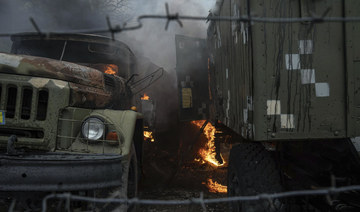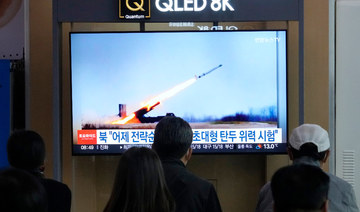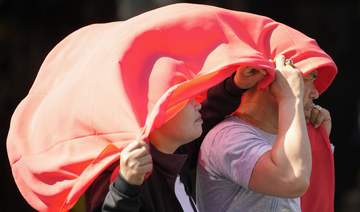WARSAW: Poland is preparing a medical train to transport Ukrainians wounded in Russia’s assault on its neighbor, the country’s health ministry said, adding that Polish hospitals were ready to receive thousands of patients.
Russian forces invaded Ukraine on Thursday, assaulting it by land, sea and air in the biggest attack by one state against another in Europe since World War Two and prompting Ukrainians to flee their homes.
“Poland is preparing to accept migrants from Ukraine, including Ukrainian citizens affected by the armed conflict,” the health ministry said in an email sent to Reuters.
In Ukraine, explosions were heard before dawn and throughout the morning in the capital Kyiv, a city of 3 million people. Gunfire rattled, sirens blared, and the highway out of the city choked with traffic as residents fled.
“We will do everything to ensure that every person who enters the territory of Poland has access to health care, including hospitalization. Beds are being prepared in hospitals for the admission of the wounded,” the Polish ministry added.
Poland’s Health Minister Adam Niedzielski said Poland has prepared a list of 120 hospitals where people affected by the conflict in Ukraine could be treated.
“In total, we estimate at the moment that it would be possible to admit several thousand patients injured as a result of hostilities, including those seriously injured,” Niedzielski said in an interview with website wp.pl.
He also said Poland was preparing a special train to transport the wounded, set up with medical equipment and personnel, a solution never before used in Poland.
“Exercises in using it are planned in the coming days. It will pick up the wounded from the border with Ukraine.”
Niedzielski also said Poland was considering the possibility of using temporary COVID hospitals set up on fairs and stadiums.
“Temporary hospitals and their future role are now being considered. At the moment, there are fewer and fewer COVID-19 patients, so they could also be used in the case the darkest scenarios come true.”
Poland prepares medical train, hospital beds for Ukrainians
https://arab.news/8sme6
Poland prepares medical train, hospital beds for Ukrainians
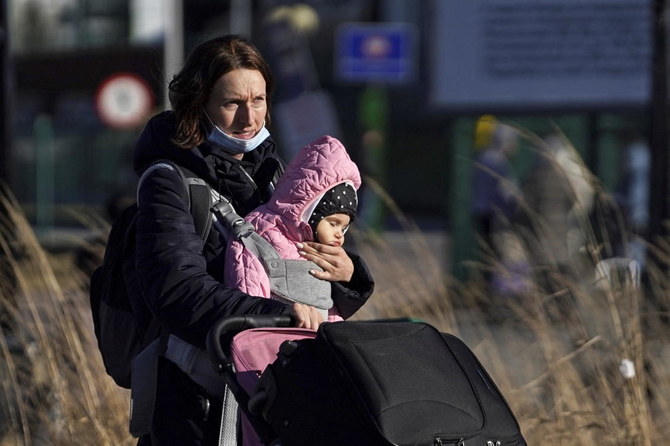
- Poland’s Health Minister Adam Niedzielski said Poland has prepared a list of 120 hospitals where people affected by the conflict in Ukraine could be treated
- Adam Niedzielski: ‘In total, we estimate at the moment that it would be possible to admit several thousand patients injured as a result of hostilities’
Death toll from south China road collapse rises to 36

Heavy rains caused a stretch of road running from Meizhou city toward Dabu county to cave in at around 2:10 am on Wednesday (1810 GMT Tuesday), according to state news agency Xinhua.
Vehicles careened into the nearly 18-meter-long (59-foot) gash in the tarmac and plummeted down the steep slope below.
Guangdong, a densely populated industrial powerhouse, has been hit by a string of disasters attributed to extreme weather events in recent weeks.
The storms have been much heavier than expected this time of year and have been linked to climate change.
China is the biggest emitter of the greenhouse gases that contribute to climate change but has pledged to reduce emissions to net zero by 2060.
“As of 5:30 am on (Thursday)... 36 people have died, and 30 people have been injured,” Xinhua said, adding that the injuries were not life-threatening.
The death toll was up from 24 people on Wednesday afternoon.
Footage by state broadcaster CCTV showed excavators digging through the muddy hillside below the collapsed road.
Nearby, a crane lifted charred, wrecked vehicles onto a lorry as people watched from behind a cordon.
State media called the road collapse a “natural geological disaster” caused by the “impact of persistent heavy rain.”
President Xi Jinping ordered officials to “go all-out in on-site rescue work and treatment of the injured, and arrange for the management of risks and hidden dangers in a timely manner,” CCTV said on Thursday.
Around 500 people have been dispatched to help with the rescue operation, it added.
The provincial government has “mobilized elite specialized forces and gone all out to carry out... search and rescue,” according to Xinhua.
An official notice on Wednesday advised that part of the S12 highway was closed in both directions, requiring detours.
Parts of central and eastern Guangdong have received up to 600 millimeters of rain in the last 10 days, three times the amount normally expected at this time of year, the national weather office said Thursday.
Up to 120 millimeters more rain was forecast for the province’s southwestern areas on Thursday, alongside further downpours across southern China until Sunday.
The conditions “raise the risk of disasters, especially geological disasters, which have a certain lag time,” the weather office said.
The emergency management ministry also warned that persistent rain would make such disasters more likely.
Officials have warned people to plan journeys carefully during the May public holiday, which runs until Sunday.
Massive downpours in Guangdong last month sparked floods that claimed four lives and forced the evacuation of more than 100,000 people.
And last week, a tornado killed five people when it ripped through the megacity of Guangzhou.
South Korea parliament approves bill on new inquiry into deadly 2022 crowd crush

- An earlier bill was vetoed by President Yoon Suk-yeol
SEOUL: South Korea’s National Assembly voted on Thursday to approve a bill backed by the ruling and opposition parties to launch a fresh probe into the deadly Halloween crowd crush in the capital Seoul in 2022.
An earlier bill, which was backed the opposition-led parliament without the support of the ruling People Power Party (PPP), was vetoed by President Yoon Suk-yeol in January.
The latest bill is a compromise that removes granting investigative power to the panel which Yoon had objected to, according to his office.
Extreme heat shuts schools for millions, widening learning gaps worldwide

- Bangladesh, Philippines, India announce school closures
- High temperatures slow down the brain’s cognitive functions, lowering pupils’ ability to retain and process information: study
Hena Khan, a grade nine student in Dhaka, has struggled to focus on her studies this week as temperatures surpassed 43 degrees Celsius (109 degrees Fahrenheit) in the Bangladesh capital.
“There is no real education in schools in this punishing heat,” she said. “Teachers can’t teach, students can’t concentrate. Rather, our lives are at risk.”
Khan is one of more than 40 million students who have been shut out of classrooms in recent weeks as heatwaves have forced school closures in parts of Asia and North Africa. As the climate warms due to the burning of fossil fuels, heatwaves are lasting longer and reaching greater peaks.
In turn, government authorities and public health experts across the world are increasingly grappling with whether to keep students learning in hot classrooms, or encourage them to stay home and keep cool.
Either decision has consequences. About 17 percent of the world’s school-aged children are already out of school, according to United Nations data, but the proportion is much larger in developing countries with nearly a third of sub-Saharan Africa’s children out of school compared to just 3 percent in North America.
Child test scores in the developing world also lag developed countries.

Heat could exacerbate inequalities, widening learning gaps between developing nations in the tropics and developed countries, experts told Reuters, and even between rich and poor districts in wealthy countries. But sending children to overheated schools could make them ill.
South Sudan already this year closed its schools to some 2.2 million students in late March when temperatures soared to 45 degrees Celsius (113 Fahrenheit). Thousands of schools in the Philippines and in India followed suit in late April, closing classrooms to more than 10 million students.
On Wednesday, Cambodia ordered all public schools to slash two hours off the school day due to avoid peak heat at midday.
Meanwhile, Bangladesh has wavered between opening and closing schools for some 33 million students amid pressure to prepare pupils for exams — even as temperatures climb to dangerous levels.
Many Bangladeshi schools “don’t have fans, the ventilation is not good, and they might have tin roofing which does not provide good insulation,” said Shumon Sengupta, Bangladesh country director for nonprofit Save the Children.
Hot heads
Even if students continue attending classes during heatwaves, their education is likely to suffer.
High temperatures slow down the brain’s cognitive functions, lowering pupils’ ability to retain and process information. US high schoolers, one 2020 study found, performed worse on standardized tests if they were exposed to higher temperatures in the year leading up to the exam.
The research, published in the American Economic Journal, found that a 0.55C (1F) warmer school year reduced that year’s learning by 1 percent. Much of that impact disappeared in schools that had air conditioning, said study co-author Josh Goodman, an economist at Boston University.
Between 40 percent and 60 percent of US schools are thought to have at least partial air conditioning, according to various surveys. Schools without it are often found in poorer districts which already trail their wealthier counterparts academically.
Goodman and his colleagues found similar learning outcomes tied to heat when they looked at standardized test data in other countries. “When (students in) these places experience a year with more heat, they appear to have learned less,” he said.
Other research suggests excessive heat in the tropics can also impact a child’s education even before birth.
Children in Southeast Asia exposed to higher-than-average temperatures in utero and early in life obtained fewer years of schooling later in life, a 2019 study in the Proceedings of the National Academy of Sciences found.
All of this is worrying, Goodman said, because as the world warms, already hot countries shifting to an extremely hot climate will suffer more than temperate countries.
“Climate change will widen the learning gaps between hot and cool countries,” Goodman said. Some developed countries are trying to address the issue.
In March, the US Agency for International Development (USAID) announced it would build 30 heat-resilient schools in Jordan by 2026 “to address the projected increase in extreme heat days in Jordan,” a USAID spokesperson said.
Providing details not previously reported, USAID said it would invest $8.17 million in the schools, using passive cooling systems and air conditioning to help keep schools operating. The number of days that schools are closed for extreme heat has been ticking up in the US, but few countries track such data.
US schools are now canceling class for an average of six to seven school days each year for heat, compared with about three to four days a decade ago, said Paul Chinowsky, a civil engineer who led a 2021 study on schools and rising temperatures for the firm Resilient Analytics.
In Bangladesh last year, schools were closed for 6-7 days, said Save the Children’s Sengupta. “But this year, they are saying it might be closed for 3 to 4 weeks,” he said, as May is often the hottest month in South Asia.
Pro-Palestinian banners. Blazing Olympic rings. Workers’ May Day rallies confront turbulent times

ISTANBUL: Workers and activists around the world marked May Day with largely peaceful protests Wednesday over rising prices, low wages and calls for greater labor rights. Pro- Palestinian sentiments were also on display.
Police in Istanbul used tear gas and fired rubber bullets to disperse thousands of people who tried to break through a barricade and reach the main Taksim square in defiance of a ban. Interior Minister Ali Yerlikaya said at least 210 people were detained.
President Recep Tayyip Erdogan’s government has long declared Taksim off-limits for demonstrations on security grounds. In 1977, unidentified gunmen opened fire on a May Day celebration there, causing a stampede and killing 34 people. On Wednesday, a small group of trade union representatives lay a wreath at a monument to victims.
May Day, which falls on May 1, is observed to celebrate workers’ rights. It’s also an opportunity to air economic grievances or political demands. “Tax the rich,” one banner in Germany read. “Don’t touch the eight-hour workday!” another read in Sri Lanka.
In Paris, police fired tear gas as thousands of protesters marched through the French capital, seeking better pay and working conditions. Police said 12 officers were hospitalized after a homemade explosive was set off on the sidelines of the march and at least 45 people were detained after instances of scattered violence
A group of protesters set makeshift Olympic rings on fire to show discontent with the Summer Games that start in less than three months. France’s unions have warned of a strike during the Games if the government does not adequately compensate people forced to work during summer holidays.
Pro-Palestinian groups joined the Paris rally, chanting slogans in support for people in Gaza. There were similar scenes in other parts of the world. In Greece, pro-Palestinian protesters joined May Day rallies, waving a giant Palestinian flag as they marched past the Greek parliament. Others displayed banners in support of pro-Palestinian protesting students in the United States.
“We want to express our solidarity with students in the United States, who are facing great repression of their rights and their just demands,” said Nikos Mavrokefalos at the march. “We want to send a message that workers say no to exploitation, no to poverty, no to high prices,” he added.
Several thousand protesters joined the Athens marches as labor strikes disrupted public transport across Greece. The largest union demands a return to collective bargaining after labor rights were scrapped during the 2010-18 financial crisis.
In the German capital, around 11,600 people marched through the immigrant neighborhoods of Kreuzberg and Neukoelln, waving Palestinian flags and holding banners that read “No weapons for Israel” or “Free Palestine,” German news agency dpa reported.
Throughout Latin America, workers marched to protest austerity measures and demand higher wages. In Argentina, unions galvanized crowds to vent their rage over libertarian President Javier Milei’s economic policies, which they say benefit the wealthy while inflicting pain on the poor and middle class.
“Paying rent is difficult, buying rice is difficult, everything under this guy (Milei) is difficult,” said 40-year-old garbage collector Leandro Rosas, trailing protesters down the street with a broom because this May Day, he said he couldn’t even surrender a shift’s pay.
Meanwhile, Bolivian President Luis Arce joined the workers’ march and decreed a 5.8 percent increase in the national minimum wage, a bid to mobilize support as a worsening economic crisis raises the specter of social unrest. The thousands-strong protests in Santiago, Chile, turned violent in some areas as security forces unleashed water cannons and tear gas on corwds, drenching and dispersing protesters who vandalized shops and government buildings.
In Brazil, President Luiz Inácio Lula da Silva ratified a law that extends income tax exemptions to those earning up to two minimum wages per month, or about $544.
“In our country there will be no tax breaks to favor the richest, but to favor those who work and live off their wages,” Lula told a crowd sweltering in the sun at a soccer stadium in São Paulo.
In Nigeria, where inflation is the highest in 28 years, at over 33 percent, unions demanded bigger salary increases. In South Africa, pro-Palestinian demonstrators joined May Day events and in Kenya, President William Ruto called for an increase in the country’s minimum wage.
In Lebanon, pro-Palestinian marchers mingled with workers demanding an end to a miserable economic crisis. “Politicians do not feel the pain of the worker or the economic conditions,” said one demonstrator, Abed Tabbaa. In Iraq, protesters demanded better wages, the reopening of closed factories and the end to privatization of certain businesses.
Tens of thousands Sri Lankans paraded through the capital as the country struggles through its worst economic crisis, two years after declaring bankruptcy. Discontent has grown over efforts to increase revenue by raising the price of electricity and imposing taxes on professionals and small businesses.
In South Korea’s capital, thousands of protesters shouted pro-labor slogans at a rally that organizers said was meant to step up criticism of what they call anti-labor policies pursued by President Yoon Suk Yeol’s conservative government.
“In the past two years under the Yoon Suk Yeol government, the lives of our laborers have plunged into despair,” Yang Kyung-soo, leader of the Korean Confederation of Trade Unions, said in a speech. Union members criticized Yoon’s recent veto of a bill aimed at limiting companies’ rights to seek compensation for damages caused by union strikes.
In Japan, more than 10,000 people gathered in Tokyo, demanding salary increases to set off price increases.
Indonesian workers demanded protections for migrant workers abroad and a minimum wage raise. They gathered amid a tight police presence, chanting slogans against the new Job Creation Law and loosened outsourcing rules.
In the Philippines, hundreds of workers and left-wing activists marched to demand wage increases and job security amid soaring food and oil prices. Riot police stopped them from getting close to the presidential palace.
Biden blames China, Japan and India’s economic woes on ‘xenophobia’
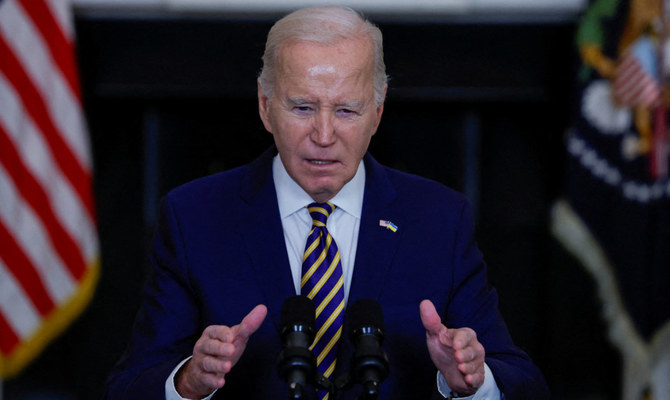
- Concern about irregular migration has become a top issue for many US voters ahead of November’s presidential election
WASHINGTON: President Joe Biden said on Wednesday that “xenophobia” from China to Japan and India is hobbling their growth, as he argued that migration has been good for the US economy.
“One of the reasons why our economy’s growing is because of you and many others. Why? Because we welcome immigrants,” Biden said at a Washington fundraising event for his 2024 re-election campaign and marking the start of Asian American, Native Hawaiian and Pacific Islander Heritage Month.
“Why is China stalling so badly economically, why is Japan having trouble, why is Russia, why is India, because they’re xenophobic. They don’t want immigrants. Immigrants are what makes us strong.”
The International Monetary Fund forecast last month that each country would see its growth decelerate in 2024 from the year prior, ranging from 0.9 percent in highly developed Japan to 6.8 percent in emerging India.
They forecast that the United States would grow at 2.7 percent, slightly brisker than its 2.5 percent rate last year. Many economists attribute better-than-expected performance partly to a migrants expanding the country’s labor force.
Concern about irregular migration has become a top issue for many US voters ahead of November’s presidential election.
Biden, who has condemned the rhetoric of his Republican opponent Donald Trump as anti-immigrant, has worked to court broad economic and political relations with countries including Japan and India to counter China and Russia globally.



